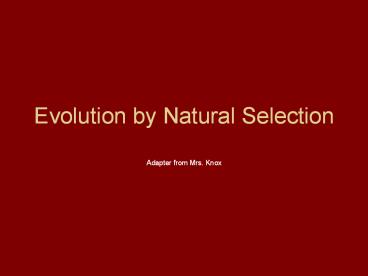Evolution by Natural Selection PowerPoint PPT Presentation
Title: Evolution by Natural Selection
1
Evolution by Natural Selection
- Adapter from Mrs. Knox
2
Charles Darwin
- Father of Evolutionary Theory
- H.M.S. Beagles Naturalist
- Studied anatomy of
- biological specimens
- formulated the Theory of Natural Selection.
3
Survival of the Fittest
- Natural Selection individuals best suited to
their environment - survive better
- reproduce better
- pass on their genes better
- Depends on variation existing in populations.
- Variation differences in appearance within the
same species. - examples hair color, feather color beak size
- Nature selects for favorable traits and against
those without them.
4
Normal Curve
- Natural variation in populations is the raw
material for evolution - Natural variation comes from genes
5
Adaptations
- Adaptations a trait which helps a species
survive. - Adaptations may take millions of years or may
occur rapidly.
6
- Peppered moth populations have evolved to a
darker form - trees become darker because of pollution
- dark moths in existence gained camouflage
- Survived better reproduced better than light
moths
7
Types of Adaptations
- Structural
- Changes in a body
- Mimicry camouflage
- Physiological
- Changes in metabolic processes
- Pesticide resistance in insects
- Behavioral
- Changes in behavior
- Social behavior in wolves or primates
8
3 Types of Natural Selection
- Stabilizing Selection selects for average
individuals and against extremes - Large spiders are easily seen captured
- Small spiders cant catch enough prey
- Medium spiders dont attract predators are
large enough to be effective predators
9
3 Types of Natural Selection
- Directional Selection selects for one extreme.
- Deep burrowing insects invade woodpecker habitat
- Those woodpeckers with longer beaks eat better,
survive better reproduce better
10
3 Types of Natural Selection
- Disruptive Selection both extremes are selected
for. - Rocks in flounder environment are both light and
dark - White and brown flounder can blend in but tan
flounder cant - Tan flounder are selected against
11
Speciation
- Natural Selection leads to the development of new
species - Species group of organisms that look alike and
have the ability to - interbreed
- have fertile offspring
12
Cause of Speciation
- Geographic Isolation physical barrier separates
population into 2 parts. - Breeding between 2 populations stops
- Over many generations populations change into new
species - Examples clear cutting, sea levels changes,
volcanic eruptions
13
(No Transcript)
14
Causes of Speciation
- Reproductive Isolation formerly interbreeding
populations are prevented from creating fertile
offspring - Example fall and spring breeding seasons
15
Speed of Speciation
- Gradualism speciation occurs at slow steady rate
with small adaptive changes gradually accumulate - Punctuated Equilibrium speciation occurs in
rapid bursts with long periods of stability in
between. - environmental conditions change
- introduction of new competitive species
16
Patterns of Evolution
- Adaptive Radiation ancestral species separate
into many species which occupy different niches.
17
Patterns of Evolution
- Divergent evolution species have become more and
more different. - Homologous structures same structure from common
ancestor, different function
18
Patterns of Evolution
- Convergent Evolution distantly related organisms
evolve same traits. - Analogous structures different structure, same
function. - fins streamline body for aquatic predators
19
Evidence for Evolution
- Fossils evidence in sedimentary rock of an
organism that lived long ago. - Amber
- Casts
- trace fossils
- Imprints
- Molds
- petrified wood
20
How do we find the age of a fossil?
- Relative dating layers of rock closer to the
surface are younger than deeper rock, so
placement of the fossil in those layers gives an
estimate of its age.
21
How do we find the age of a fossil?
- Radiometric dating using the amount of
radioactive isotopes left in the fossil to
estimate its age. - Half-life the amount of time it takes for half
of a specific radioactive isotope to decay. - Potassium 40 turns into
- Argon 40 over time
- 1/2 life 1.3 billion years
- Carbon-14 5730 years
22
- C-14 Dating Procedure
23
Evidence for Evolution
- Comparative Anatomy comparing body parts of
species. - homologous analogous structures
24
Evidence for Evolution
- Comparative Embryology if embryos appear similar
then there is a common ancestor.
25
Evidence for Evolution
- Vestigial structures body part that is reduced
in function today, but may have been used by
ancestors.
26
Evidence for Evolution
- Genetic Comparisons DNA testing to see how many
pairs of nucleic acids are similar. - Most reliable form of evidence.

